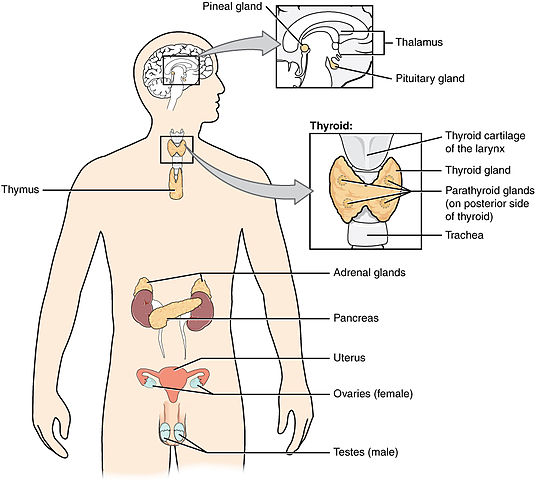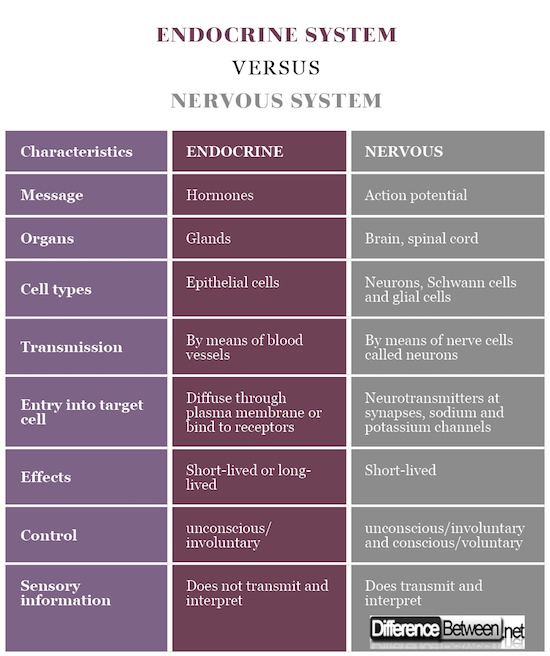Difference Between Endocrine System and Nervous System
What is Endocrine System?
Definition of Endocrine System:
The endocrine system is a system of glands that produce chemical messages called hormones which have an effect on various target cells throughout the human body.
Organs involved in Endocrine System:
The organs of the endocrine system are all glands that are found throughout the human body. Glands of the endocrine system often secrete more than one hormone, e.g. the adrenal gland which secretes adrenaline and cortisol.
Glands in the head region include the pituitary and pineal gland, which are found in the hypothalamus of the brain. The anterior part of the pituitary gland secretes hormones that trigger other glands to release hormones. The thyroid gland and parathyroid glands are both found in the neck region; pancreas and adrenal glands are both found in the abdomen. Reproductive glands include the ovaries in females and testes in males.
Transmission involved in Endocrine System:
Hormones are secreted by epithelial cells of the gland and then transported through the blood vessels to a target cell. At the cell the hormone will diffuse through the plasma membrane if it is soluble in lipids, else if not lipid-soluble it will bind to a hormone receptor on the plasma membrane. The transmission speed is somewhat slow since transmission is by means of the blood.
The transmission of hormones is always involuntary and not under conscious control. The response to a hormone may be short-lived but can be long-lived as well. For example the hormone adrenaline provides a short term response while the hormone cortisol provides a long term response.
Effects of Endocrine System:
There are several different types of hormones having a variety of effects, and acting by negative feedback mechanisms so as to maintain homeostasis. Growth, metabolism, water balance in the body, response to stress and inflammation, can all be regulated by the endocrine system.
What is Nervous system?
Definition of Nervous System:
The nervous system consists of the brain, spinal cord, and several nerve cells and fibers which send signals around the body in the form of a nerve impulse known as an action potential, which has an effect on a target cell.
Organs involved in Nervous System:
The organs of the nervous system include the brain and spinal cord. The brain is divided into several regions which have various functions and are responsible for interpreting information received via nerve input. The spinal cord attaches to the brain at the posterior region. It joins the brain stem or medulla oblongata of the hind brain. Various nerves enter and leave the brain and spinal cord. The spinal cord is also responsible for reflex arcs. The brain and spinal cord constitute the central nervous system while sensory and motor nerves (neurons) constitute the peripheral nervous system.
Transmission involved in Nervous System:
The message is transmitted as a nerve impulse called an action potential. The action potential is an all or none event and involves changes in the membrane potential of the axon of a nerve cell. The transmission can be under voluntary and involuntary control and brings about a localized response. The transmission speed can be very fast because nerve axons are myelinated allowing for rapid saltatory conduction. Response to the impulse is usually rapid and short-lived. Transmission of nerve impulses relies on specialized cells called neurons which are supported by Schwann cells and glial cells. Transmission can be under voluntary control (motor part of somatic system) and involuntary control (autonomic nervous system).
Effects of Nervous System:
Nerve impulses travel to and from the brain and spinal cord. Sensory receptors and organs all have sensory neurons (nerves) that travel to the brain where the information is interpreted. A response is then sent back along motor neurons to an effector. The effector can be a muscle or organ.
Difference between Endocrine System and Nervous System
-
Messengers involved in Endocrine System and Nervous System
Hormones are the chemical messengers in the endocrine system while nerve impulses called action potentials are the messengers in the nervous system.
-
Organs of Endocrine System and Nervous System
Glands are the organs of the endocrine system while the brain and spinal cord are the organs of the nervous system.
-
Cell types of Endocrine System and Nervous System
The nervous system includes nerve cells called neurons, Schwann cells, and glial cells, while the endocrine system includes epithelial cells.
-
Transmission in Endocrine System and Nervous System
Hormones are transmitted through the blood vessels while nerve impulses are transmitted by nerve cells called neurons.
-
Entry into target cell
Hormones either diffuse through a plasma membrane or bind to cell receptors. Nerve impulses use neurotransmitters at synaptic clefts and sodium and potassium channels.
-
Effects of Endocrine System and Nervous System
Nerve impulses in the nervous system have a rapid short-lived effect, while hormones of the endocrine system can have a slow long-lived effect or a rapid short-lived effect.
-
Control of Endocrine System and Nervous System
The nervous system is under both unconscious/involuntary control and conscious/voluntary control, while the endocrine system is under unconscious/involuntary control.
-
Sensory information in Endocrine System and Nervous System
The nervous system is involved in transmitting and interpreting sensory information while the endocrine system is not involved in transmitting and interpreting sensory information.
Table comparing Endocrine System and Nervous System
Summary of Endocrine System verses Nervous System
- The endocrine system and nervous system both work together to ensure homeostasis.
- The endocrine system consists of glands that secrete hormones that travel through the blood vessels to a target cell.
- The nervous system transmits nerve impulses known as action potentials that move through neurons.
- Action potentials involve sodium and potassium channels, and neurotransmitters at synapses.
- Hormones can move through a cell membrane or bind to receptors on the cell membrane.
- Nerve impulses tend to be short-lived while hormones can be both short-lived or long- lived.
- The endocrine system is under involuntary control while the nervous system can be under voluntary control in addition to involuntary control.
- Difference Between Rumination and Regurgitation - June 13, 2024
- Difference Between Pyelectasis and Hydronephrosis - June 4, 2024
- Difference Between Cellulitis and Erysipelas - June 1, 2024
Search DifferenceBetween.net :
Leave a Response
References :
[0]Betts, J. Gordon. et al. Human Anatomy and Physiology. Houston: Rice University, 2017. Print
[1]Matthews, Peter B.C.. “Human Nervous System.” Science. Encyclopedia Britannica, 2018, https://www.britannica.com/science/human-nervous-system
[2]Utiger, Robert. D. “Human Endocrine System.” Science. Encyclopedia Britannica, 2018, https://www.britannica.com/science/human-endocrine-system
[3]Image credit: https://upload.wikimedia.org/wikipedia/commons/b/ba/Nervous_system_diagram.png
[4]Image credit: https://upload.wikimedia.org/wikipedia/commons/thumb/1/15/1801_The_Endocrine_System.jpg/536px-1801_The_Endocrine_System.jpg



